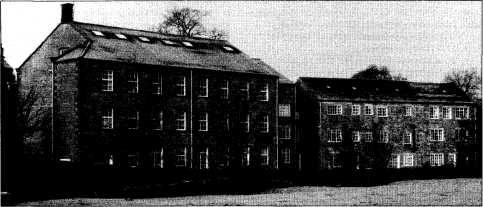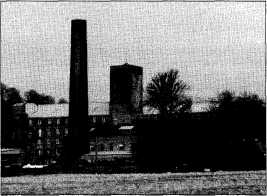| JOURNAL 1997 |
| North Craven Heritage Trust |
In the last quarter of the 18th Century a number of inventions were to turn the manufacture of textiles in England from domestic cottage based industry into the world's first factory based one. The effect of these inventions was to transform the lives of the thousands of people in the north of England within just a few decades.
The first phase of the growth of the factory system, which took place before the end of the Napoleonic Wars, largely preceded the age of steam. It was not until the second quarter of the 19th Century that steam powered factories of far greater size overtook the smaller water powered ones which had grown up throughout the valleys of northern England. From soon after the Battle of Waterloo, both rural domestic textile industry and smaller, less efficient, water-powered mills embarked on a long and steady period of decline. This was more than compensated for by the rapid transformation of small market towns to great industrial textile ones. It is these towns, with their great steam powered palaces of industry and attendant thousands of red brick terraced houses providing the disciplined labour force to work them, that are most recognised as the face of the industrial revolution that transformed this country.
In the years before the age of steam the valleys of the north of England had been no less affected by the arrival of water powered textile mills, firstly for cotton. In geographic terms while the cotton industry developed in central Lancashire and Derbyshire it soon spread throughout the county, into the West Riding of Yorkshire, Westmorland and Cumberland. Thus it was a corn mill in Airton was extended, within a very few years of the building of Arkwright's first mill at Cromford on the river Derwent in Derbyshire in 1771. Airton Mill, which goes back to the 15th Century or earlier, was added to provide for the spinning and weaving of cotton by Mr Alcock and a number of local businessmen in 1787. Langcliffe Mill, also dating from the end of the 18th century, and run by John, George and William Clayton, was to receive a letter from John Hartley of Catteral Hall in early January 1803 asking for their first annual return to the Justices of the Peace giving a record of the number of Parish Apprentices employed. The return was required under the terms of the Health and Morals of Apprentices Act of 1802. In the Manchester Weekly Times of 21st November 1792 appeared the following item: "Run away from Hodgson, Capstick and Co. at Caton Cotton Mill, Nr Lancaster. 10 Parish apprentices taken out of the workhouse at Liverpool, viz. William Moore aged 14 years, a stout made lad about 5 feet 3 ins high, round broad face, fair complexion, light hair, had on when he went off, a drab roundabout top jacket, self-grey waistcoat, a pair of trousers and shoes tied...
Thomas Tyrer aged 13 years, rather round face, short brown hair, had when he went off, a drab coloured coat, self-grey trousers.. .John Tyrer aged 15 years, about 5 feet 4 ins high, dark brown hair, goes rather lame and wide with his toes.. John Young aged 14 years, about 5 feet 3 ins high, dark brown hair. Had on, when he went off, a drab coloured coat, self-grey waistcoat and white flannel breeches. Ran away four days ago... The following ran away at different dates some time ago.
Thomas Williams, 17 years of age and tall for his age.
William Bevan, 15 years of age, a stiff, stout lad rather marked with small pox. Thomas Kelly, 16 years of age, a dull countenance, rather knock-kneed. James M'Lauchlin, 14 years of age. Thomas Edwards, 13 years of age. Peter M'Leod, 14 years of age. Whoever will give information where any of them are or will bring any of them to John and Thomas Hodgson, Merchants in Liverpool or to Hodgson, Capstick and Co. aforesaid will be paid all reasonable demands and whoever harbours or employs any of them will be prosecuted as the law directs." Behind this advertisement lay a system of employment of parish poor from considerable distances away and in some cases in their cruel abuse in rurally located textile mills where no one was concerned with their welfare.
The problem lay in the fact that the factory system developed in sparsely populated and isolated regions. The isolation of these mills, which often employed from 150 to 600 people, resulted in employers looking far afield for docile labour to run their machinery. Women and children were ideal as manual dexterity was of more importance than physical strength. They also had the advantage of being easily reduced to passive compliance with their employers and they were cheap to employ. The parish apprentices had the additional advantage of being bound to their masters for long periods, typically for a minimum of 7 years and often until the age of 21.
This shortage of labour was to be met enthusiastically by parishes throughout the country who wished to rid themselves of their poor at a time when they were becoming an increasing burden. In 1695 it has been estimated that the population of England and Wales was 5,500,000. The census of 1803 (when corrected for errors) indicated that the population had risen to 9,200,000. The population, which had risen slowly until about 1750 rose rapidly in the last half of the century. This rise coincided with a period of more than 25 years of war with France. By the end of the war close to a quarter of the Gross National Product was used for military and naval purposes. As the supply of national wealth available for private citizens reduced, prices rose sharply and wage earners and the poor suffered increasing hardship. During these years of war pauperism increased alarmingly with a resulting pressure on the parish Poor Rate. In 1803 one in nine of the population (over a million people) received relief. The old poor law relied on the parish as a unit of government and on unpaid non-professional administrators. As the administrative units were small so was the availability of cash for each parish. One result was a strong local feeling that the parish was only responsible for its own poor and also if a means could be found to be rid of them it should be taken.
Mill owners and parish officials struck bargains without a thought for the welfare of the children who were often treated like commodities. Thus lots of 20 to 100 children were supplied from poor houses from as far apart as London and Liverpool. They were sent like cattle to isolated rural mills where they lived as virtual prisoners for years. Some parishes, who drove particularly hard bargains, insisted that the manufacturer had to take a crippled or mentally retarded child for every 20 or so able bodied parish apprentices.
The abuse of these children largely went unnoticed and unchallenged. Often the only limiting factor on the hours these children worked was their complete exhaustion. It was reported in 1816 that the average hours worked were 16 per day. In a system where the overseer was paid on the basis of what was produced every inducement was used to extract more work from the children. In most cases production never ceased and beds never got cold. Exhaustion resulted in many accidents, with limbs crushed and lost. Discipline was often brutal.
In 1822 an apprentice named Robert Blincoe was discovered by J Brown who was looking into the moral and social effects of the factory system. Blincoe joined his first mill in 1799 along with 80 other boys and girls. Here they were regularly whipped for the smallest fault and in order to keep them awake. If the children tried to escape they had their feet put in irons. Many tried to commit suicide. Blincoe attracted the unwelcome attention of Robert Woodward, the overseer, who for a punishment regularly suspended him over moving machines at a height that he had to keep his knees bent to avoid having them crushed. While his case was particularly savage it was by no means unusual. Food was often very poor—at one mill the children had to struggle with the pigs in the yard for extra food. The interior of these early mills was often dark and cramped and the air filled with cotton dust. These conditions led to lung disease and deformed bodies. Inevitably epidemics resulted and many died. In one mill so many children died the owner had to spread the burials around a number of parishes to avoid attracting attention.
This abuse of the apprentice system resulted in thousands of children growing into adulthood with deformed bodies and without even the trace of education. Their ignorance resulted in many being equipped for nothing else but a life of drudgery as adults in mills where they remained in conditions little better than slavery. One employer, William Sidgwick was asked in 1816 by a commission sent to investigate conditions in cotton mills what he did to help sick apprentices. He answered, "When we engage a child, it is with the approbation of the parents, and it is engagement to give a certain quantity of money for a certain quantity of work. If the labour is not performed, the child is supported by the parents". He was then asked if any support was given to a sick child. He stated that this was an act of bounty only.
The Health and Morals of Apprentices Act of 1802 was a first hesitant step to improve the conditions of approximately 20,000 children employed in rural mills, many dozens of which were in the Craven area. The origin of the Act was in large measure a result of a well founded fear for public health and of epidemics. The importance of the Act was more in the fact that it was the first time Parliament had legislated for the conditions in mills than the limited impact it had on the working condition of children employed in them. Over the next 50 years further Acts of Parliament would address all types of workers and conditions in factories, gradually improving them and also shortening hours of work.
James Heaton wrote his MA thesis while at Rhodes University, South Africa, on The Evolution of the Working Conditions and Associated Legislation of Apprentices and Child Labour in British Factories and Trade of the Late Eighteenth Century to the Middle of the Nineteenth Century. He was also curator of the War Memorial, Canberra, Australia.

J1997p1_9_files/tmp4F8-1.jpg
Airton Mill. Photo James Heaton

J1997p1_9_files/tmp4F8-2.jpg
Langcliffe Mill. Photo James Heaton.